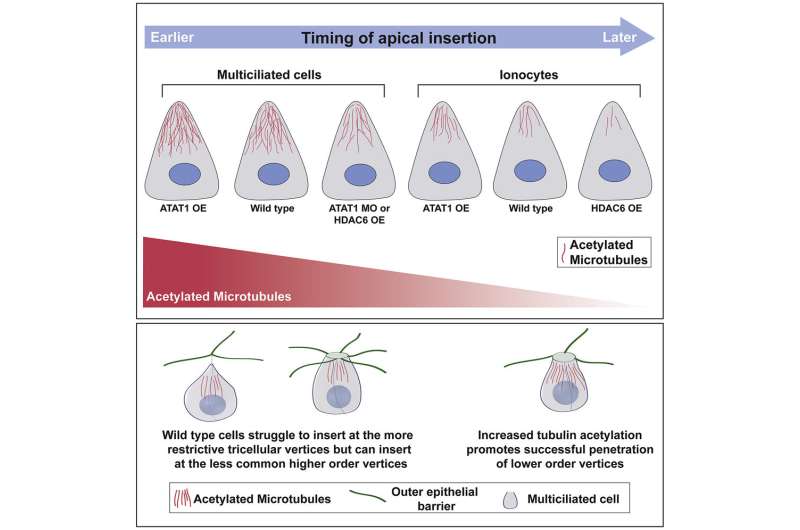Strengthened microtubules aid cell migration

Migrating cells use stiffened microtubules to push through tissue barriers, seeking out weak points in tissue, according to a Northwestern Medicine study published in Cell Reports.
These findings shed light on the specific role of microtubules in cell migration, according to Brian Mitchell, Ph.D., associate professor of Cell and Developmental Biology and senior author of the study.
"Microtubules are very dynamic, constantly growing and shrinking, but this process stabilizes them so they're more resistant to strain and gives cells the strength to poke through tissue," said Mitchell, who is also a member of the Robert H. Lurie Comprehensive Cancer Center of Northwestern University.
Cell migration is fundamental to maintaining the proper organization of cells within the body. During development, large-scale migrations help build the central nervous system. In adult organisms, cell migration is essential for immune response, wound repair and tissue homeostasis.
Previous studies have outlined microtubules' role in aiding cell migration, according to Mitchell. In the current study, Mitchell and his collaborators measured the penetrative ability of cells in which they both positively and negatively modulated tubulin acetylation, finding that cells with more acetylation improved their ability to penetrate tissue. Cells with more acetylated microtubules are both faster at penetrating through the tissue and less picky about where they penetrate, according to Mitchell.
The investigators also examined the other side of this equation: the tissue barrier. Most tissue is made up of cells joined at junctions, which are most often joined to another at three points—a three-vertex junction—and this type of connection is relatively strong. However, some cell junctions had additional connection points, making four or five-vertex junctions that are weaker.
Working with physicists at University of California, Irvine, including Clare Yu, Ph.D., professor of Physics & Astronomy and a co-author of the paper, the authors developed a mathematical model that predicted, based on junction strength, where cells would attempt to migrate through the tissue.
The investigators then observed migrating cells as they searched for weak spots in tissue, finding that they almost never migrated through three-vertex junctions and instead gravitated towards weaker, higher-order junctions.
"It matched the model perfectly and shows the strength of this type of modeling in these situations," Mitchell said.
Epithelial tissue provides a barrier function for liquids, toxins and infectious agents. Further characterizing the tug-of-war between the epithelium trying to keep cells out and cells finding spots to penetrate has implications for both development and diseases such as infectious disease or cancer.
More information: Caitlin Collins et al, Tubulin acetylation promotes penetrative capacity of cells undergoing radial intercalation, Cell Reports (2021). DOI: 10.1016/j.celrep.2021.109556
Journal information: Cell Reports
Provided by Northwestern University

















